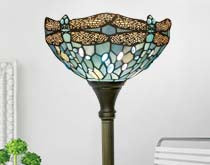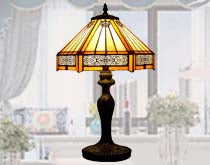How to Measure a Tiffany Ceiling Lamp
Tiffany ceiling lamps are an excellent choice for space lighting due to their versatility, fit in small spaces, and availability in different designs and styles. When placed properly, these lights can provide beautiful ambient lighting to your room. However, with so many options, you'll have to measure to get a light fixture that's the right size for your space.
Related reading: What Is Tiffany Ceiling Lamp?
The Tiffany ceiling lamp is an example of a flush mount ceiling light. Measuring it involves determining the scale and clearance of the fixture. You can measure a Tiffany ceiling lamp or other flush mount ceiling lights by doing the following:
- Turn off power to the existing lighting fixture
- Gather the necessary tools
- Measure the room
- Measure the width of the light
- Measure the height of the light
- Measure the mounting holes
- Determine the right wattage
- Consider bulb type and install
Flush mount ceiling lights are an excellent choice for most of your spaces. They provide general and ambient lighting to your small rooms, hallways, walk-in closets, and other spaces.
Choose from different sizes of Tiffany ceiling lamps in Werfactory tiffany lamps.
They give your room a clean, modern, and ornamental look, irrespective of the size of your room. The remaining part of this article extensively explains the steps of measuring a flush mount ceiling light to ensure it fits perfectly within your space.
1. Turn off Power to the Existing Lighting Feature
Ensure you are safe before you start measuring your room and flush mount ceiling light. Turn off the power to the existing light fixture at the fuse box or circuit breaker.
Confirm that the power is indeed off by testing the switch of the fixture. Remember to wear safety glasses to protect your eyes and use a sturdy ladder to access your ceiling safely.
2. Gather the Necessary Tools
Have all the tools you will use to measure your flush mount ceiling light in one place. This will minimize movements and ensure you concentrate on the task at hand.
You will need the following tools for the project.
- Pencil
- Paper
- Measuring tape
- Electrical tape
- Voltage tester
- Step stool
The tape measure will help get accurate measurements, and you will use the pencil and paper to write down your measurements. The voltage tester will be useful in confirming there is no electrical current so you can carry on with the project safely.
Gather all the tools in one place, especially in the room where you intend to measure the flush mount ceiling light. Doing so will simplify the process and enhance efficiency.
3. Measure Your Room
Before you measure your flush mount ceiling light, it is important to understand the dimensions of your space. In this regard, measure the length and width of your room and the ceiling height.
Other than the size of your room, the weight and style of the light also affect the size of the lighting fixture for your room.
4. Measure the Width of the Light
The diameter or width of the flush mount ceiling light is a primary measurement that depends on the shape of your fixture. Getting a lighting fixture that fits well within your space is advisable.
Therefore, measure the diameter of the flush mount ceiling light by putting your measuring tape across its center, from one side to the other. Record this measurement on your paper using the pencil.
If the fixture is rectangular or square, measure the width from one end to the other. Ensure you measure the widest part of the flush mount ceiling light, then record the measurement on paper.
Alternatively, you can use the room's measurements to determine the width of your lighting fixture. Using the measurements of your room, convert the number to inches to calculate the width of the flush mount ceiling light.
After measuring the length of your room in feet, add it to the room's width. The total should be the width of the fixture in inches. For example, if your room measures 12 by 18 feet, change their sum of 30 into inches. Therefore, the width of your light should be 30 inches wide.
However, this rule is not applicable in all scenarios and depends on the room where you intend to install your flush mount light. For example, a ceiling light over your dining space must be slightly narrower to balance different elements of the dining room.
5. Measure the Height of the Light
Although the height of the fixture is not a primary measurement, it is also important. If your ceiling is low, measuring the height of the flush mount ceiling light will help you install one that gives enough clearance for tall people.
In this regard, measure the distance from the ceiling to the bottom of the fixture using your measuring tape. Then record the measurement on the piece of paper.
The measurement shows how far the ceiling light extends downwards from your ceiling. Alternatively, you can determine the height of your light by measuring the height of your ceiling in feet and multiplying it by three.
For example, the flush mount ceiling light should be approximately 30 inches tall if your ceiling is 10 feet tall.
Flush mount ceiling lights, especially Tiffany ceiling lamps such as the one shown below are ideal for your space if your ceiling is low. Such lights brighten your space and take little space, leaving enough room for you and your guests to move freely without hitting your head.

6. Measure the Mounting Holes
Different flush-mount ceiling lights have different numbers of mounting holes to hold them firmly to the ceiling.
Some have multiple holes, while others have few.
Measure the distance between the mounting holes to ensure you align your lighting fixture properly during installation.
7. Determine the Right Wattage
Determining the right wattage is necessary to achieve enough illumination of your space. Also, it makes it possible for your flush-mount ceiling light to provide ambient lighting to your room.
Measure the wattage of your light by multiplying the height and width of your room to get a square footage. Once you have the square footage, multiply it by 1.5 to get the watts needed for your room.
Knowing the wattage of the light will help you use a bulb that matches the lighting fixture’s ratings. Some lighting fixtures have a wattage rating printed on them, especially on the insulation or below the globe.
If the flush mount ceiling light uses more than one bulb, it is best to measure the total wattage of all the bulbs. Ensure the total wattage does not exceed the rating of the lighting fixture. This will help in avoiding damage to your ceiling lamp.
8. Consider Bulb Type and Install
Measuring your flush mount ceiling light helps in determining the best bulb types to use. The right bulb for your light depends on the purpose of the fixture.
For example, you have to ask yourself whether the ceiling light is for mood lighting or illumination of a specified area? Also, the bulb type depends on your ideal flush mount ceiling light style.
Below are the flush-mount ceiling light styles that can influence the bulb type you will use on your lighting fixture.
- Traditional. This style gives your space a vintage and classic look. Flush mounts of the traditional style can fit in traditionally inspired themes and other décor styles.
- Contemporary. This features simple designs that align with aspects of modernity and gives your room a minimalist flair.
It is ever-changing and seamlessly complements the design and theme of most rooms.
- Transitional. This style merges elements of contemporary and traditional styles. It is experimental, and you can try it out with the intention of bringing a subtle touch to suit the style of your room.
Therefore, if your preferred style is traditional, you must consider bulb types that will give your room a vintage and high-quality look and improve your space’s aesthetic appeal.
Also, you need to ensure the bulb type fits into the traditional lighting fixture. Once you have identified the right bulb type that matches your style and fits in the lighting fixture, install the flush mount ceiling light.
If your lighting fixture has more than one light source, consider the space among them. Ensure even distribution of the bulbs within your lighting fixture.
Conclusion
An ideal flush mount ceiling light fits perfectly into your available space and suits your style. They are suitable for you if your space has little hanging room, for example, an apartment with limited room for pendants like the one shown below.

Before identifying a fixture that matches your style, you must ensure the size will fit your space and accommodate your ideal bulb type.
Carefully measure your room and lighting fixture and choose the one that balances your space, illuminates it, and gives it a good impression.
For example, a small flush-mount ceiling light is best if you have a small, narrow space. The small light will illuminate and evenly distribute the light in such spaces.
Related reading: Tiffany Chandeliers vs. Tiffany Ceiling Lights

























